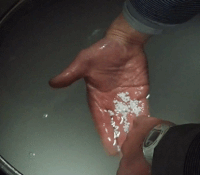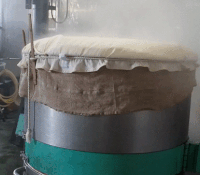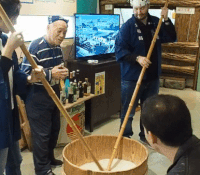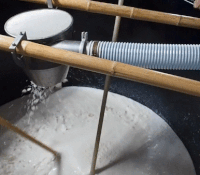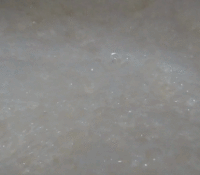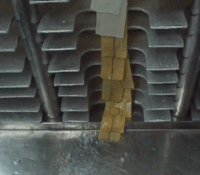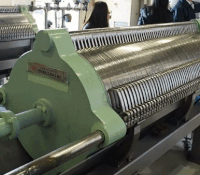Production
| Table of contents |
|---|
Rice Polishing
• One of the most important operations is the rice polishing as to reduce the level of fat and proteins, in same time the polishing percentage will give the grade or “appellation”, the higher the polishing the higher the grade, Futsuu (regular saké), Sanzõshu & Junmai saké do not have a minimum milling, Honjozo have at least 70% remaining, Ginjo and Junmai-Ginjo have 60% minimum and for the top sakés, Daiginjo & Junmai-Daiginjo 50%.
Rice Washing
• Next the rice is washed to take out any rice dust (nuka) left over from the polishing process.
Rice Soaking
• Then soaked to increase the rice moisture levels. That will allow the koji mould to get to the center of the kernel and support the grains to break up more easily during the fermentation process. To achieve the desired moisture levels different techniques can be applied once the higher is the polishing ratio (semi-buai), the less time it takes to absorb water. Using cold water will slow down the water absorption, small batches to be more precise and control the timing with a stopwatch.
Rice Steaming
• And after steamed to sterilise and get the rice to correct moisture level and texture (firm from the outside and soft on the inside). The main goal is to gelatinize the starch allowing the saccharification process. You can steam the rice though continues steamers or the traditional way, one batch each time.
Rice Kōji Making
• From there 1/3 of it will be set aside in a Kkōji room, this room is 35°C high in temperature and 85% high in humidity, the rice is laid down over a long table and the kōji-kin, which is an enzyme, is sprinkled over the rice in order to break down the starches into glucose. This operation takes two days and it is called the saccarification.
Shubo Making
• After two days the rice becomes crystallized, and is used to make the Shubo (starter mash) in a small tank.
• There is 2 types of Shubo (Moto) methods, Kimoto (Allowing lactic acid bacteria occurring naturally) and Sokujo (Adding lactic acid)
Kōbo (Yeasts)
• Yeast is a tiny living organism measuring 5-8 microns (1/1000 of 1mm), which carries out alcohol fermentation.
• Yeast's important roles: 1. Making alcohol from sugar 2. Creating aroma compounds 3. Creating acids, organic compounds
Moromi
• After, this koji-rice is brought back to the original tank and water is added with some yeasts. The process is unique through the transformation of the starches into glucose and from the glucose into alcohol; this is called a multiple parallel fermentation. • Fermentation last 1 month while for the wine it is 4 to 15 days. This longer fermentation at low temperature (11-13°C) will produce twice more amino acids than wine. Those are important in the perception of Umami. • At the end of the fermentation the saké hold an alcohol content of 20%. • This will be naturally reduced by addition of pure spring water. Saké’s average alcohol content is between 15% and 16%. From there we get to the two categories of saké: Junmai saké are pure rice and Ginjo mean there is a little addition of alcohol, not brings up the alcohol content but to make the saké fuller bodied and more complex while Junmai tends to be drier and more delicate.
Pressing Methods
• Using Gravity: 1. Fukuro-tsuri. The moromi is placed in sacks and is left to slowly drip out, due to gravity. This method produces delicate sake called Shizuku. • Fune (flat vertical press): • Mechanical Pressing Methods: 1. Centrifugal Press 2. Membrane Filter Press
Sedimentation & Racking
• After pressing, the sake will rest in a tank for around 3 to 10 days, with the enzyme and yeast sediment (ori) settling at the bottom – Orizake. • The clear sake at the top is siphoned off before filtration.
Filtration
• Powdered carbon (activated carbon) is added to the sake, before being run through a filter. This removes unwanted flavour elements and the natural amber colour of sake. • Traditionally brewers use persimmon tannin for the same purpose.
Pasteurization (at 60℃ – 65℃)
• Different methods: 1. By passing the sake through a coiled metal pipe which is sitting in a vat of heated water 2. By immersing bottled sake in hot water (Binkan Hiire)
Tank Storage (Maturation)
• The majority of saké is stored for 6 months before it is ready to be sold though certain Ko-shu (aged saké) can be left to mature for 3 to 10 years for example.
Blending
• The aroma and flavour of sake varies from tank to tank. Brewers blend them to create the desired taste for each sake.
Water addition (Warimizu)
• To lower the alcohol content and to adjust the flavor, water is added. If water is not added, this results in Genshu. (Sake can reach the highest alcohol percentage of any fermented beverage in the world.)
Bottling
• “Binzume” is the process of filling seishu into bottles. This can be done by modern machines (tsume-kuchi) or by hand (te-zume) and either with hot sake (nesshu binzume) or cold sake (binkan binzume).

